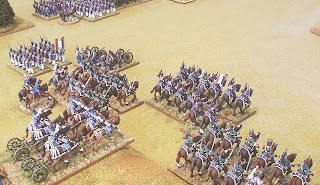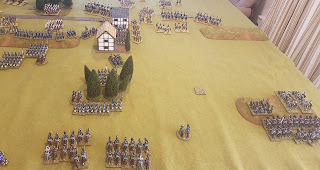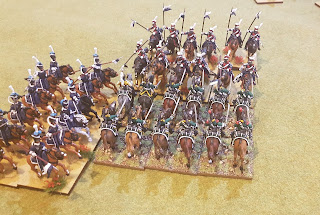It has been a while since I've updated the blog with a post, but I've been favouring gaming and painting in free time over blogging recently. :) Plus the points based games which we have been playing are not as interesting as historical refights to blog about I think. However, we did do a historical refight today, with the battle of Gorzyce in 1809 - Austrians attempting to evict a Polish Army from territory they claim in the 1809 campaign.
This is a scenario taken from the Roads to Vienna scenario book by Michael Hopper, and slightly modified. Matt used his Polish (painted as Vistula legion but ignore that!), and I used my Austrians.
Brigades involved were:
Polish: Poniatowski (2 Command rerolls)
Rozniecki Infantry (2VP): 4 Line, 1 Skirmishers, 1 Foot Artillery
Rozniecki Cavalry (2VP): 2 Uhlans, 1 Chasseur
Kamieniecki Infantry (1VP - arrives turn 2): 2 Line, 1 Recruit Line, 1 Skirmishers
Kamieniecki Cavalry (2VP - arrives turn 2): 1 Uhlan, 1 Chasseur, 1 Horse Artillery
Austrian: Ferdinand (1 Command reroll)
Branowaczky Infantry (1VP): 2 Light Infantry (Grenz), 1 Skirmishers, 1 Foot Artillery
Branowaczky Cavalry (1VP): 1 Hussar, 1 Small Hussar
Trautenberg (3VP): 3 Large Recruit Line, 1 Recruit Line, 1 Cuirassier
Speth (3VP - arrives turn 2): 2 Large Line, 1 Line, 1 Cuirassier, 1 Horse Artillery
The battlefield is very sparsely populated in this one! The 12 x6 foot table represents an area of roughly 3 miles by 1.5 miles. Key features are the dike berms (represented by hedges), which are a significant defensible obstacle for purpose of shooting and melee (not defensible by cavalry), plus hindrance to movement over them. The Austrians (on the left in photo below, are attempting to get one or more units within a foot or so of the hamlet on the board edge on the right. In addition to getting a Victory Point (VP) if they achieve this, and the Poles getting a VP if they prevent this, breaking enemy formations (removing more than half of the units in them), achieves a number of victory points shown for each Brigade above.
The Battle
The main attack starts on the left. Further Austrian and Polish reinforcements are due to arrive on the right flank turn 2.
Hussars on the Austrian left flank.
Austrians get lucky with a first assault, and capture the first built up area with a hasty assault on turn 2.
On the right flank, both Austrian and Polish reserves arrive.
The Austrians make it to the dike berm, though of course they will need to cross it to break the Polish lines and achieve victory.
The next attacks on the left go poorly, and two large Austrian units are bloodily repulsed. The Poles lack numbers to defend everywhere though, so the first Austrian unit is able to advance over the dike berm, hoping the artillery misses...
Polish Uhlans and Chasseurs engage on the left, running down a Grenz battalion and even managing to bloody a Cuirassier regiment.
Austrians close in on the Hamlet, though the Infantry is halted by combined arms, and Cuirassiers slow as they stop to cross the berm.
On the right large Austrian units and more Cuirassiers cross the dike berm, after the Austrian Horse Artillery gets lucky in silencing its Polish counterparts.
The Poles smash the small Austrian regiment on the right, but will be hard pressed to hold against the Austrian numbers.
On the left the Polish Cavalry manage to rout the Austrian Hussars, but their own formation takes heavy casualties and breaks under artillery fire while attempting to regroup a couple of turns later.
End of the game, the Austrians manage to push through the Polish lines and hold the area. Kamieniecki's light cavalry perform heroically and are able to force the two Cuirassier regiments back, but Austrian infantry swamps the defences.
Rozniekis Brigades are broken as is Branowaczky Cavalry. Branowaczky's Infantry is very close to breaking. Nonetheless a decisive Austrian Victory with 5VP to 1VP.
A few other shots at the end of the battle.
Conclusion
An interesting battle this one, with the Poles facing a tough decision about whether they have a consolidated defence on the dike berm nearer the objective, or whether they also try to defend the more advanced dike berm to slow the first Austrian advances. With so few troops it might also be great for cavalry except of course for the dike berms slowing movement down and interfering with melee.
Troop gradings also need considering for this one. I had rated the second rate troops here as "Recruit" which is a middle grading between Raw and Regular infantry. In rules used these count as Regular morale until half of bases in a unit are disordered at which point they drop to Raw morale. It might have been better to start these at Raw morale so they are always at a disadvantage compared to Regular troops. I had been concerned that the Polish had quite a strong defensive position and not that many fewer troops than the Austrians. However, the larger Austrian units and deployment arrival timings mean it is quite a challenge for the Poles I think, so a Raw grading might have been better so that such units were always at a disadvantage in morale, rather than just after they had taken some damage.
In any case I recommend giving this refight scenario a try, and interesting to fight on a field the size of the Battle of Aspen Essling, but with far fewer troops involved!
.jpg)

.jpg)
.jpg)
.jpg)
.jpg)
.jpg)
.jpg)
.jpg)
.jpg)
.jpg)
.jpg)
.jpg)
.jpg)
.jpg)
.jpg)
.jpg)
.jpg)
.jpg)
.jpg)
.jpg)























